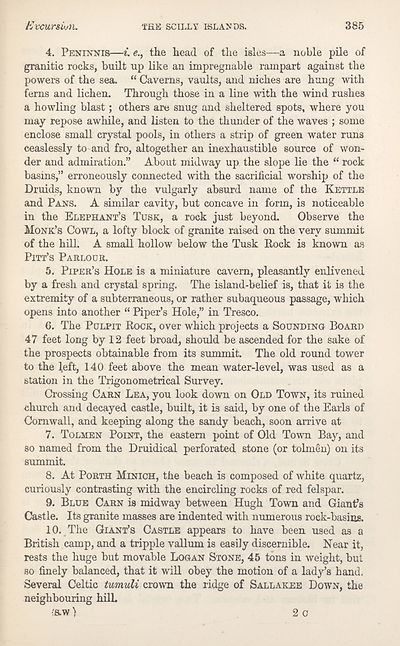Download files
Complete book:
Individual page:
Thumbnail gallery: Grid view | List view

E vcursMi.
TRE SC ILLY ISLANDS.
385
4. Peninnis—i. e., the head of the isles—a noble pile of
granitic rocks, built up like an impregnable rampart against the
powers of the sea. “ Caverns, vaults, and niches are hung with
ferns and lichen. Through those in a line with the wind rushes
a howling blast; others are snug and sheltered spots, where you
may repose awhile, and listen to the thunder of the waves ; some
enclose small crystal pools, in others a strip of green water runs
ceaslessly to and fro, altogether an inexhaustible source of won¬
der and admiration.” About midway up the slope lie the “ rock
basins,” erroneously connected with the sacrificial worship of the
Druids, known by the vulgarly absurd name of the Kettle
and Pans. A similar cavity, but concave in form, is noticeable
in the Elephant’s Tusk, a rock just beyond. Observe the
Monk’s Cowl, a lofty block of granite raised on the very summit
of the hill. A small hollow below the Tusk Rock is known as
Pitt’s Parlous.
5. Piper’s Hole is a miniature cavern, pleasantly enlivened
by a fresh and crystal spring. The island-belief is, that it is the
extremity of a subterraneous, or rather subaqueous passage, which
opens into another “ Piper’s Hole,” in Tresco.
6. The Pulpit Rock, over which projects a Sounding Board
47 feet long by 12 feet broad, should be ascended for the sake of
the prospects obtainable from its summit. The old round tower
to the left, 140 feet above the mean water-level, was used as a
station in the Trigonometrical Survey.
Crossing Carn Lea, you look down on Old Town, its ruined
church and decayed castle, built, it is said, by one of the Earls of
Cornwall, and keeping along the sandy beach, soon arrive at
7. Tolmen Point, the eastern point of Old Town Bay, and
so named from the Druidical perforated stone (or tolmen) on its
summit.
8. At Porth Minich, the beach is composed of white quartz,
curiously contrasting with the encircling rocks of red felspar.
9. Blue Carn is midway between Hugh Town and Giant’s
Castle. Its granite masses are indented with numerous rock-basins.
10. The Giant’s Castle appears to have been used as a
British camp, and a tripple vallum is easily discernible. Near it,
rests the huge but movable Logan Stone, 45 tons in weight, but
so finely balanced, that it will obey the motion of a lady’s hand.
Several Celtic tumuli crown the ridge of Sallakee Down, the
neighbouring hilL
•aw) 2 o
TRE SC ILLY ISLANDS.
385
4. Peninnis—i. e., the head of the isles—a noble pile of
granitic rocks, built up like an impregnable rampart against the
powers of the sea. “ Caverns, vaults, and niches are hung with
ferns and lichen. Through those in a line with the wind rushes
a howling blast; others are snug and sheltered spots, where you
may repose awhile, and listen to the thunder of the waves ; some
enclose small crystal pools, in others a strip of green water runs
ceaslessly to and fro, altogether an inexhaustible source of won¬
der and admiration.” About midway up the slope lie the “ rock
basins,” erroneously connected with the sacrificial worship of the
Druids, known by the vulgarly absurd name of the Kettle
and Pans. A similar cavity, but concave in form, is noticeable
in the Elephant’s Tusk, a rock just beyond. Observe the
Monk’s Cowl, a lofty block of granite raised on the very summit
of the hill. A small hollow below the Tusk Rock is known as
Pitt’s Parlous.
5. Piper’s Hole is a miniature cavern, pleasantly enlivened
by a fresh and crystal spring. The island-belief is, that it is the
extremity of a subterraneous, or rather subaqueous passage, which
opens into another “ Piper’s Hole,” in Tresco.
6. The Pulpit Rock, over which projects a Sounding Board
47 feet long by 12 feet broad, should be ascended for the sake of
the prospects obtainable from its summit. The old round tower
to the left, 140 feet above the mean water-level, was used as a
station in the Trigonometrical Survey.
Crossing Carn Lea, you look down on Old Town, its ruined
church and decayed castle, built, it is said, by one of the Earls of
Cornwall, and keeping along the sandy beach, soon arrive at
7. Tolmen Point, the eastern point of Old Town Bay, and
so named from the Druidical perforated stone (or tolmen) on its
summit.
8. At Porth Minich, the beach is composed of white quartz,
curiously contrasting with the encircling rocks of red felspar.
9. Blue Carn is midway between Hugh Town and Giant’s
Castle. Its granite masses are indented with numerous rock-basins.
10. The Giant’s Castle appears to have been used as a
British camp, and a tripple vallum is easily discernible. Near it,
rests the huge but movable Logan Stone, 45 tons in weight, but
so finely balanced, that it will obey the motion of a lady’s hand.
Several Celtic tumuli crown the ridge of Sallakee Down, the
neighbouring hilL
•aw) 2 o
Set display mode to:
![]() Universal Viewer |
Universal Viewer | ![]() Mirador |
Large image | Transcription
Mirador |
Large image | Transcription
| Antiquarian books of Scotland > Adventure and adventurers > Black's guide to the counties of Dorset, Devon, & Cornwall > (430) |
|---|
| Permanent URL | https://digital.nls.uk/142591539 |
|---|
| Description | Thousands of printed books from the Antiquarian Books of Scotland collection which dates from 1641 to the 1980s. The collection consists of 14,800 books which were published in Scotland or have a Scottish connection, e.g. through the author, printer or owner. Subjects covered include sport, education, diseases, adventure, occupations, Jacobites, politics and religion. Among the 29 languages represented are English, Gaelic, Italian, French, Russian and Swedish. |
|---|

